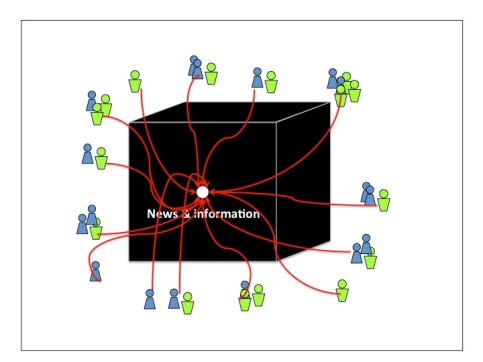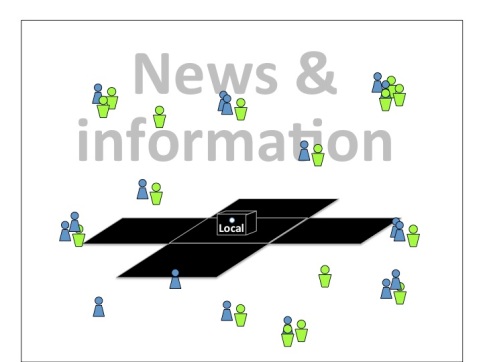Desperately needed: More innovation on the audience side
Posted by Steve Gray
Just how disrupted is the old newspaper business model — the model that’s centered on providing news to a geographic market?
A lot more disrupted than many people in the news media think.
The local media industry is scrambling to innovate around sales. This is seen, for example, in the race to create new digital sales teams and agencies selling digital marketing solutions to small and medium businesses. And the industry is innovating around costs by consolidating, outsourcing and otherwise whacking at the high costs of producing and distributing its products.
But I don’t see a lot of innovation happening around the content model that’s been the basis of the newspaper business for the last 100 — even 200 — years.
It seems that most of the news industry still believes that gathering and distributing the news is a sufficient model to support the business. And this is despite overpowering evidence of steadily declining print circulations and steadily shrinking digital audience shares.
I’ve made this case before — here, and here, for example. But I still think the massive and fundamental disruption of our content model — or, more accurately, our audience-creation model — is not well understood.
This time, I’ll try a visual treatment.
Let’s go back to the 1950s — the heyday of the printed news business model.
Back then, news was hard to gather, hard to transmit, hard to publish and hard to distribute — and we had all of that well in hand. We had reporters for local news and teletypes and wire services for news from around the region, nation and world. And we had printing presses and carrier forces for distribution.
In that technology-challenged era, very little new information arrived in the home each a day. Radio brought some — mostly entertainment, plus some national news. Television was in its infancy, with a few channels providing mostly entertainment. The only full-service source of the day’s latest news and information was the newspaper.
Figuratively, news and information was a black box, inaccessible to the average person . Consumers had to depend on someone else to go into the box and get it, organize it into a product and deliver it. So our newsrooms met an urgent and otherwise unmet need for virtually everyone in the population.
In effect, the local newspaper company gave people an entry point into the black box — a portal to the most important new information emerging every day.
And absolutely everyone came in through it. My father, who was a circulation manager in the 1950s, recalled that at one point he became curious about who lived in those few homes that didn’t subscribe. So he knocked on some doors to find out.
The answer: People who couldn’t read, or who couldn’t read English.
We had a lock on the entire literate population. Penetration levels above 90 percent of households were common in city zones.
This was a marvelously lucrative proposition. Not because we charged people a lot for the content, but because businesses were eager to put their messages alongside the content and paid dearly for the privilege. We had a position of great market strength, because the newspaper was the only place where the whole population could be reached.
This goes a very long way back. A copy of the Augusta Herald dated 1799 hangs on the wall in the offices of Morris Publishing Group, where I work. The entire front page is filled with advertisements from local businesses announcing their new shipments of goods or their fine services. The portal was working then, just as it did for the next 200 years.
So let’s sum up the model: We had a portal consisting of otherwise nearly unavailable news and information; it attracted almost everyone, and businesses paid handsomely for the privilege of being displayed there.
Now let’s jump ahead to today. How does that picture look?
Simply stated, the walls have fallen down.
News and information is all around us, no longer contained by technological barriers and high cost. The average person can get at most of the world’s information with a few clicks of a mouse or a few touches on a mobile screen.
As Henry Blodget of Business Insider put it, “…(in) the old world through 1995, media organizations were the equivalent of a hydrant in the desert. They controlled the vital information flow. They had tremendous power because they were the gateway.
“Now, we are a hydrant in an ocean. Media organizations are often still coming at it from the point of view, ‘Wait, we get to choose what’s important. People should consume it because we say it’s important.’
“The point that I’m making is there is so much out there to consume right now that you actually have to build something that people like.”
Right on. People don’t have to come through our portal to get most of the information and news they need. They go anywhere they want, for any information that interests them.
So what’s left of our old business model?
On the consumer side, some members of our local populations still like the ’50s model — using a daily print portal for a complete aggregation of the day’s news. But that number has fallen from 90 percent of households in the 1950s down to 40- or 30-percent range for most dailies in the U.S. — even on Sunday. It’s even worse if you look beyond city zones to retail trading zones, where weekday penetrations are often in the teens.
It’s not much better on the digital side, where only about 10 percent of our monthly unique visitors come back even five times in a month. Our digital competitors — led by Google and Facebook — are capturing up to 20 times as many visits per month as we are.
Now that the box is gone, all the parts of our content package that aren’t local — national and international news, sports, business, entertainment, recipes, movie reviews, etc. — are available to our non-readers in limitless amounts from the Internet. The only space where we still have a chance of offering exclusive content is the little black box labeled “Local.”
On the sales side, this puts our advertising model in deep trouble, too. Businesses are struggling to figure out how to reach the huge and growing number of people and households that no longer read print. Businesses need to hang their ads where the non-readers are going, so they’re spending more and more on digital solutions: web sites, targeted and retargeted display, search-engine marketing, Google AdWords, Facebook targeted ads, Facebook pages, mobile landing pages and so on.
Quite a few local media companies — let’s not call ourselves newspaper companies — are fighting for those advertising and marketing dollars by offering all of those solutions in their local markets.
But I don’t see them fighting for the huge share of the local audience they’ve lost. I see two possibilities:
1 — Fight for the news audience with better, more personally relevant content. We need ringmasters running our newsrooms, determined to bring their audiences the greatest show on earth every day, as I described here.
2 — Fight for local audiences that don’t give a hoot about news. The big black box may be gone, but that smaller black box of local information remains — the many things people need to know that are native to their market but not provided by any convenient source.
Take off the news blinders, and you see that local people have strong interests in a long list of local information categories that we mostly don’t provide. In a recent brainstorming session with people from The Augusta Chronicle’s newsroom, we came up with this list of possibilities:
- Buzz — what local people are talking about
- Events — things I might want to see or participate in
- Stuff to know about other people
- Personal safety
- Things I should try to avoid/things I might want to take advantage of
- What the cool people here are doing, talking about, or like/don’t like
- What the knuckleheads, sociopaths and oddballs are doing
Add to that list the big category of commercial information — who’s selling what, what’s on sale, where the good deals are. Our ads only scratch the surface.
All of these topics are person-centered, not “news” centered. There’s a huge amount of this kind of information in every community, and people would gladly consume it, if only someone would figure out how to provide it.
So how can we gather it? How we should present it? How would we market it, so everyone knew about it?
We’re local media companies. That doesn’t mean we’re just local news companies. How can we innovate in the huge, still largely untapped space of local, personally relevant information?
Posted on October 14, 2013, in Audience, circulation, Consumer revenue, Content, Disruption, innovation, Media business model, Newsrooms, Paid content, Revenue and tagged audience accountability, audiences, content, coverage, definition of news, disruption, disruptive innovation, diversification, mass media, media, media disruption, newspaper, newsrooms, traditional media. Bookmark the permalink. 4 Comments.


I agree with everything that you’ve posted. I would also suggest that in addition to being the ringmaster for local entertaining content, newspapers have the opportunity to be cheerleaders for local business development. Newspapers have historically been thought leaders and well as news portals. The information transformations aren’t just changing newspaper business models. They are changing ALL business models including the fundamental reasons why communities exist. Newspapers have an opportunity to become vision leaders in communities who are seeking to redefine their sense of place, cope with an aging population, and adjust as we move from a manufacturing/agricultural economy to an information/entertainment economy.
LikeLike
Gents, I agree with both of you. Capitalism eats its own and those that do not innovate and experiment will fail. From presentation and a leadership perspectives, the typical news organization needs to innovate quickly, fail fast and move on, tweaking constantly. There is no status quo on any media or audience front. News organizations need to be supple, technically efficient and prepared to provide thought leadership. The magic is in that mix, just like the needle in the haystack. Keep looking, inventing, telling, showing and moving on.
LikeLike
There isn’t even the slightest doubt in my mind that location-based information delivery will be the dominant information delivery means very shortly. It does not whether the platform is Google Glass-like, smart phone, iWatch, or an embedded chip in one’s brain or body. The delivery of relevant information is tied to an individual’s location, time and intent. Foursquare claims to have a new map that can influence or predict behavior. http://readwrite.com/2013/10/09/foursquare-real-time-recommendations#awesm=~okkU9R4OfAyECV We have the content now. We just need to place it with an individual where and when it is most relevant. This is not a difficult concept to understand. And, it is happening now.
LikeLike
Pingback: One more time: Our content is failing our industry | MediaReset